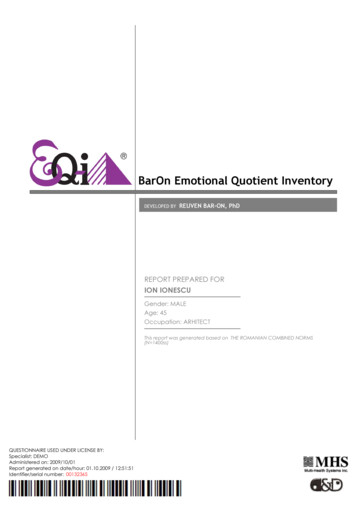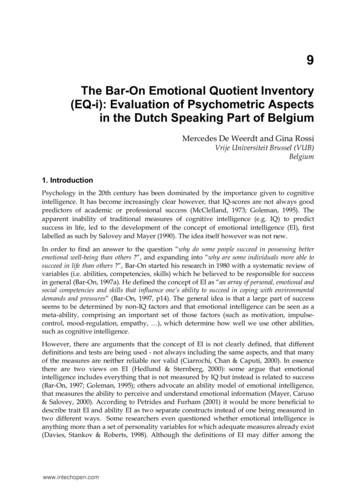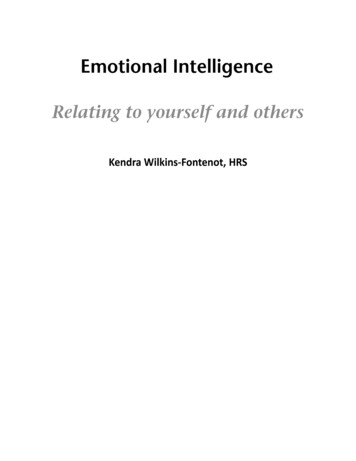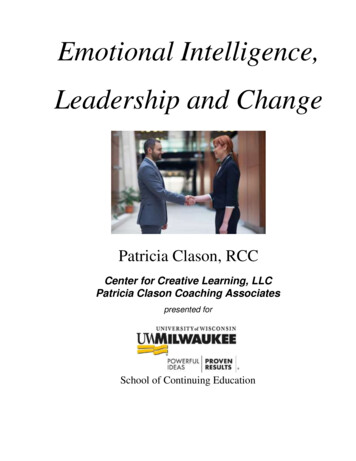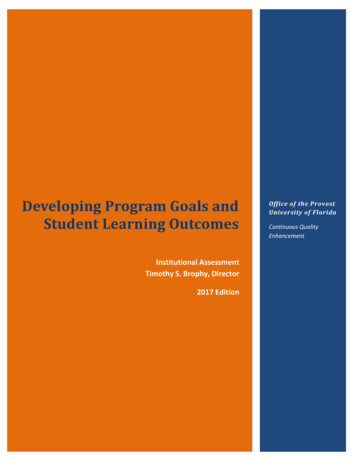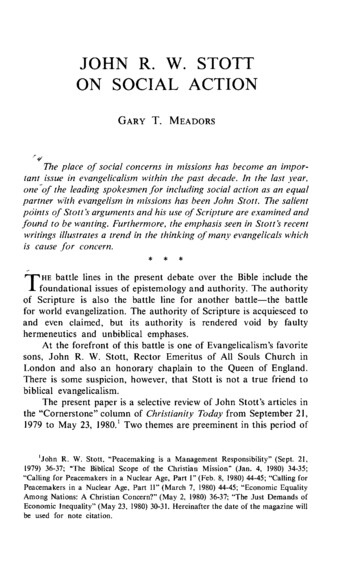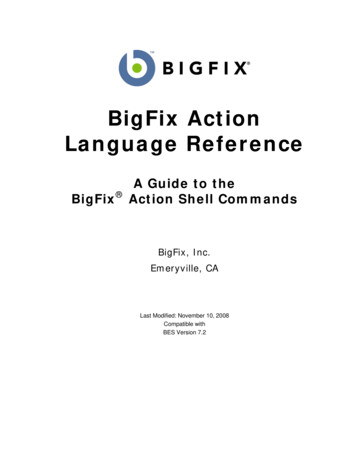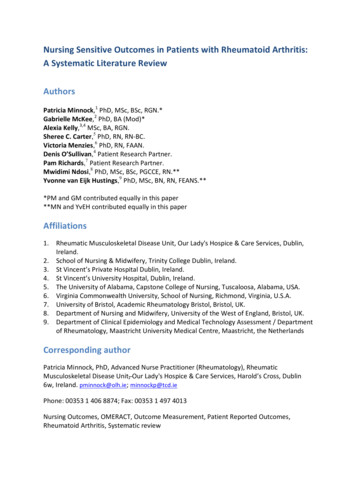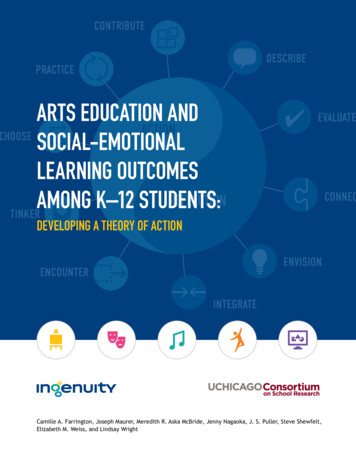
Transcription
CONTRIBUTEDESCRIBEPRACTICEARTS EDUCATION ANDACTIONCHOOSESOCIAL-EMOTIONALLEARNING TECONNECDEVELOPING A THEORY OF ACTIONENVISIONENCOUNTERINTEGRATECamille A. Farrington, Joseph Maurer, Meredith R. Aska McBride, Jenny Nagaoka, J. S. Puller, Steve Shewfelt,Elizabeth M. Weiss, and Lindsay Wright
Montessori School of Englewood
TABLE OF CONTENTSEXECUTIVE SUMMARY4INTRODUCTION6Overview of ReportCHAPTER 1: Arts Education and Social-Emotional Learning: A Theory of Action710Developmental Experiences and Relationships10A Theory of Action for Arts Education and the Development of Social-Emotional Competencies12Art Practices and Social-Emotional Components14Art Education Process15Art and Social-Emotional Competencies16Cultural Beliefs about Arts Education18CHAPTER 2: Exploring Arts Education and Social-Emotional Learning in Practice22Self-Management and Self-Discipline22Interpersonal and Relationship Skills27Self-Expression and Identity31Summary35CHAPTER 3: Conclusions and Implications36Opportunity Is Critical to Development36Intentionality Ensures That Opportunities Are Fully Leveraged37Lessons for Other Subjects38What Research Is Needed39Conclusion39WORKS CITED41ACKNOWLEDGMENTS463
ARTS EDUCATION AND SOCIAL-EMOTIONAL LEARNING OUTCOMES AMONG K–12 STUDENTS: DEVELOPING A THEORY OF ACTIONEXECUTIVE SUMMARYSocial and emotional learning is a topic ofincreasing focus in the education sector. Thoughdefinitions and terminology vary, at its corethis trend reflects an increased interest amongeducators, administrators, parents, and otherstakeholders in students’ development ofindividual and interpersonal skills beyond therealm of academic achievement.Across existing research literature and among artseducators there is widespread belief that artisticdisciplines including music, dance, theatre, visualarts, literary arts, and media arts have a positiveeffect on children’s and adolescents’ social-emotionaldevelopment. This project investigates the relationshipbetween arts education and social-emotional learningand develops a theory of action describing the nature ofthat relationship.This project consists of two components: a review ofliterature on this topic and an interview-based fieldworkcomponent with educators, administrators, students, andparents in Chicago Public Schools. Our literature reviewhighlights the strength of the research into arts educationand social-emotional learning with regard to focused,qualitative case studies and the gaps with regard toexperimental or randomized control trials. Combining thisarts-specific research with multidisciplinary literatureon child and adolescent development and insights fromour fieldwork interviews, we propose a theory of actionthat describes how arts learning experiences have thepotential to promote young people’s development ofsocial-emotional competencies.4Our theory of action starts from the premise that eachlarge-scale art education process (e.g., taking pianolessons, putting on a theatrical production, or doing alesson on graffiti) consists of many smaller-scale actions(e.g., practicing a piece for a recital, rehearsing a scene,or choosing statements to express through graffiti).We argue that each of these small-scale actions, or artpractices, also includes social-emotional components.To offer just one example for each, the piano practicecould include using breathing and mindfulness to dealwith performance anxiety, the theatre rehearsal couldinclude working with other students to accomplish agoal with minimal adult supervision, and thinking aboutexpression in graffiti could prompt students to reflecton the feelings about events going on in their lives. Justas the art practices themselves are the building blocksof long-term art competencies (e.g., skill at playingthe piano, performing a play, or creating graffiti), thesocial-emotional components are the building blocksof long-term social-emotional competencies (e.g.,improved emotional self-regulation, responsibility andawareness of peers’ emotional states, and confidencein expressing complex ideas stemming from personalthoughts and feelings). Our theory emphasizes thatthe artistic and social-emotional aspects are alwayshappening simultaneously and that, just as a studentcan learn good or bad piano habits, she can learn goodor bad social-emotional habits. Just as the art practicesmust be cultivated into long-term art competenciesthrough guidance and instruction, the social-emotionalcomponents of these activities must be cultivated intolong-term social-emotional competencies.
EXECUTIVE SUMMARYThis report has three sections. The first describes ourtheory of action in greater detail, emphasizing thedevelopmental effects of arts education. The secondsection surveys evidence in three areas of socialemotional development: self-management and discipline,interpersonal and relationship skills, and self-expressionand identity. It also provides illustrative examples of thetheory of action drawn from literature and our fieldworkinterviews. The third and final section describespractical implications of this work and suggests areasfor further research.1Our conclusions are relevant to both the practitioner andpolicymaking levels. First, exposure to a range of artsopportunities is crucial in helping students to identifyand engage with learning contexts that will fit theirown social-emotional needs. Second, arts education hassocial-emotional effects regardless of instructor intent—and these effects can be either positive or negative.It is crucial for educators to be intentional in the social-emotional contexts they create through their lessons.Third, while we argue that arts education is particularlywell-suited to social-emotional development for avariety of reasons, it is by no means unique in thisregard. There are lessons that educators in non-artssubjects can draw from the mechanisms whereby artslearning has a positive social-emotional impact onchildren and adolescents.Overall, this report emphasizes that arts educationsettings are sites of great potential. Learning literaryor media arts, visual arts, theatre, dance, or music hasgreat intrinsic benefits for young people, as they areexposed to creative humanistic experiences and thepotential for rigorous skill development. However, withdeliberate planning and awareness, a skilled instructorcan shape these lessons into spaces for deep andlasting development of those young people’s social andemotional skills and well-being.ArtReach Chicago at Walsh Elementary School1 To download an electronic version of this report and to view a technical appendix, please visit: k–12-students5
ARTS EDUCATION AND SOCIAL-EMOTIONAL LEARNING OUTCOMES AMONG K–12 STUDENTS: DEVELOPING A THEORY OF ACTIONINTRODUCTIONI think that arts, in a lot of ways, really lendthemselves to expression and independenceand voice, which under different terms are allparts of social-emotional learning. And so I thinkthere’s a very, very natural sort of relationshipwith the arts and expression. And developingsome of those skills—heart, mind and work,compassion, or kindness—because of the way weteach arts here, it involves a lot of collaboration,a lot of partnership and team building, [as wellas] demonstrations of what you know. There’sa lot of engagement with other people in orderto really understand that what you’re doing iscorrect or that you’re working toward a goal.— Arts educator in the Chicago Public SchoolsSchools have long played a critical role in preparingstudents to be productive members of society inadulthood. Over the past few decades, this role hasbeen largely defined in academic terms—ensuring thatstudents have learned the knowledge and skills theyneed to be successful in college and career. In thiscontext, the value of arts education in school has mostoften been framed as an instrument to enhance schoolengagement and academic learning, either indirectlythrough connections between an arts education andacademic outcomes,2 or directly through incorporatingarts curricula with instruction in other subjects(i.e., arts integration).3At the same time, a growing movement is advocating forthe idea that the outcomes we ultimately care about inour children reflect a broader set of concerns related tosocial-emotional development: Are they good and kindpeople? Are they contributing members of their familiesand their communities? Are they able to set goals andpursue their dreams? Are they productive, helpful peoplein the workplace?The benefits of broadening our understanding of thedevelopmental outcomes of schooling go beyond theindividual to contributing to the larger social fabric.In a country that is both rich in diversity and deeplydivided socially and politically, with stark and wideningeconomic inequality, many are calling upon schools toteach empathy, social responsibility, civic engagement,and the skills to communicate with one anotheracross differences.4 Employers and higher educationadministrators are also emphasizing the importance of“21st century” or “college- and career-ready” skills suchas innovation, collaboration, perseverance, and critical62 Hetland & Winner (2001); Melnick, Witmer, & Strickland (2008), Catterall, Dumais,& Hampden-Thompson (2012).3 Ludwig, Marklein, & Song (2016); Burnaford, Brown, Doherty, & McLaughlin (2007);Deasy (2002).4 Borba (2018); Kudo & Hartley (2017); Rivkin (2009); Spencer-Keyse (2018).
INTRODUCTIONthinking in young people for success in the workplaceand in college. We are interested here in understandinghow arts education can influence the development of thisbroad set of competencies and attributes that we considerunder the umbrella “social and emotional” learning.social-emotional competencies. We intend that thistheory of action will provide a clearer understanding tosupport adults in organizing arts education experiencesthat more intentionally provide opportunities for socialemotional development.In addition to the development of particularcompetencies as desired outcomes of learning,researchers from a range of disciplines havedemonstrated that the process of student learningis inextricably social and emotional.5 Learning inthe arts is no exception. Whether in school or out ofschool, in self-directed learning or through peer-topeer interactions, the arts provide a wide range ofopportunities for social-emotional experiences as wellas developing social-emotional competencies. Some artseducation experiences culminate in a polished productor performance meant to be shared; others emphasizethe process of creating art performances or products.Sometimes, arts education is viewed as a means ofinstilling discipline and tenacity by teaching students theexacting requirements of mastering new ballet positionsor learning to play runs on the saxophone while instillingthe importance of practice. Arts education is alsoseen as a vehicle for self-expression, helping studentsexplore aspects of their identity and express emotionsthat are not encouraged at other times in the schoolday. And some arts education provides opportunitiesfor collaboration and building social skills, for examplethrough being part of a theatre production or a memberof an orchestra.6To this end, the focus of our model is on how artseducation fosters social-emotional development.Though many practitioners feel that arts educationhas a transformative effect on students’ personaldevelopment, we examine the evidence base for theseclaims and work toward a better understanding of themechanisms by which arts education might have animpact. While we believe that art—and consequently aneducation in the arts—matters for its own sake, the aimof this theory of action is to give adults insights to helpthem be more intentional in leveraging arts educationtoward social-emotional development.This report examines the intersection of arts educationand social-emotional development. We use the lens ofsocial-emotional learning to examine and articulatehow arts education, beyond its intrinsic value, can helpyoung people develop into productive, emotionallyhealthy, and engaged adults. Arts education has a roleto play not only in building artistic skills, but also inbuilding critical competencies and mindsets that can betransferred to other subject areas, and as an importantpart of the overall development of young people.7 Thisreport investigates how an education in the arts can helpachieve these objectives.Overview of ReportA primary goal of this project is to propose a theoryof action describing the role arts education can playin children’s social-emotional development and themechanisms by which arts education can affect5 Cantor, Osher, Berg, Steyer, & Rose (2018); Jones & Kahn (2017); Immordino-Yang (2016).6 As discussed in the box in Chapter 1, arts education creates opportunities for each of the10 developmental experiences identified in Foundations for Young Adult Success.To conduct this research, we did an extensive reviewof research literature and held focus groups andinterviews with key participants in the arts educationprocess. We talked to arts teachers, teaching artists,arts administrators, and students and their families,to get a picture of how they conceptualize the role thatarts education plays in social-emotional development.We interviewed both arts teachers (arts educators onthe staff of a K–12 school who usually have educationdegrees and/or state certification) and teaching artists(arts educators who are not formal members of a schoolfaculty, but have professional experience in the artform they teach) to ensure that we captured a rangeof perspectives on approaches to teaching in the arts.We also took a deep look at the literature on artseducation to evaluate the evidence, based on its effectson social-emotional learning, particularly in school andafter-school settings. Across the research literature,we found much belief and conjecture that arts educationcontributes to children’s and adolescents’ socialemotional development. Like previous reviews of theliterature, however, we found few studies that weregeneralizable or sufficiently rigorous to make strongempirical claims about a direct contribution of the artsto social-emotional outcomes as a matter of course.8A large percentage of available studies looking at socialemotional outcomes in arts education were qualitativeexaminations of a particular art program in a particularsetting, drawing from researcher observations andparticipant interviews. Also common were correlational7 Foundations for Young Adult Success (Nagaoka, et al., 2015).8 Hetland & Winner (2001); Melnick et al. (2008).7
ARTS EDUCATION AND SOCIAL-EMOTIONAL LEARNING OUTCOMES AMONG K–12 STUDENTS: DEVELOPING A THEORY OF ACTIONstudies using self-report surveys in which arts programparticipants reported higher levels of social-emotionalcompetencies than non-participants. Unfortunately, mostof these studies lacked sufficient controls or failed toaddress concerns with self-selection, and few studiesused quasi-experimental methods or randomized controltrials that could identify causal effects. Further, almostall studies focused on art programs as the unit of analysisrather than attending to the mechanisms whereby aparticular art form or type of artistic practice led tospecific social-emotional outcomes. In short, existingstudies do not provide evidence that would allow us todraw a reliable line between any particular art practiceand a corresponding social-emotional outcome.That being said, the evidence taken as a whole doessuggest that the arts have an important role to playin supporting the social-emotional development ofchildren and youth. We provide examples of studiesthat connected arts participation to social-emotionaloutcomes, as well as examples from our fieldwork thatmade similar connections. Importantly, we draw onearlier reviews of the broad, multidisciplinary literatureon child and adolescent development9 to hypothesize howarts education may well provide a particularly powerfulcontext for young people’s social-emotional learning.that they associate with these painful feelings. This isnot to say that arts instructors should shy away fromuncomfortable or challenging content or situations—indeed, providing challenge in a safe space is one ofthe catalytic opportunities available in arts education.Rather, we hope our theory of action helps practitionersto better understand how arts education can contributeto long-term social-emotional outcomes so arts educatorsact responsibly and effectively to create powerfullearning experiences that serve the best interests oftheir students’ long-term development.We have divided this report into three chapters. Inthe first chapter, we describe our theory of action andhighlight the principles of developmental experiencesand developmental relationships that underlie it. Thenext chapter explores what this theory looks like inpractice through three lenses on social-emotionaldevelopment: self-management and discipline,interpersonal and relationship skills, and self-expressionand identity. In the final chapter, we provide implicationsof the theory of action for practice and suggest areaswhere further research is needed.We have organized the results of this knowledgecollection into a theory of action that describes the rolearts education can play in children’s social-emotionaldevelopment and the mechanisms by which artseducation can affect social-emotional competencies.Our primary aim for this theory of action is toilluminate for practitioners how arts educationcan best foster social-emotional development—and consequently to help practitioners be morethoughtful and intentional in their design of artscurricula.10 Though arts education can be a powerfulforce in supporting students’ social-emotionaldevelopment, a major takeaway from this project is thatthis does not happen automatically. Even where we sawevidence of arts education having significant effects onsocial-emotional development, there was much variationin outcomes among participants and across settings. Insome circumstances, the effects of arts participationcan be negative: Young people may feel deeply exposedor ashamed, or come away convinced that they lackcreativity or artistic talent. They may well go throughlife purposefully avoiding future situations involvingvisual arts, music, theatre, dance, or other art forms89 Farrington et al. (2012); Nagaoka et al. (2015).10 We also see opportunities for this project to yield other benefits. For example, thetheory here can support arts education advocates and others who seek to more clearlyexpress why arts education matters by articulating how arts education can play a role indevelopment and engagement in school. For researchers, we hope this project can laythe foundation for future research on the relationship between arts education and socialemotional development, including ways to expand and deepen the conversation to includemore stakeholders.
INTRODUCTIONChanging Worlds and Manierre Elementary School9
ARTS EDUCATION AND SOCIAL-EMOTIONAL LEARNING OUTCOMES AMONG K–12 STUDENTS: DEVELOPING A THEORY OF ACTIONCHAPTER 1Arts Education and Social-Emotional Learning:A Theory of ActionHuman learning is a deeply, fundamentally social andemotional process. Researchers across a broad range ofdisciplines (e.g., cognitive, developmental, and socialpsychology; neurobiology; epigenetics; education; youthdevelopment; linguistics; sociology; economics) arecoming to consensus about the deep interconnectionsamong cognitive, emotional, and social-relational aspectsof human functioning, which together form the bedrockof learning and development.11 Much recent researchdemonstrates the interconnected nature of learning:from experimental studies showing the importanceof human interaction for early language recognitionin infants (a phenomenon that can’t be replicated byexposing infants to audio recordings of human voiceswithout a physical human speaker present),12 to researchdemonstrating that college students’ perceptions of theirenvironments impacts their academic performance,13 tolongitudinal studies that identify a boost to learning thatcomes from a student of color having a teacher of thesame race,14 to functional magnetic resonance imaging(fMRI) technologies that show real-time connectionsbetween emotions and thinking in the human brain.These studies largely support what great arts educatorsand arts theorists have long intuited: that learning is asocial and emotional enterprise.15 It is within this richand complex social context of learning that we examinethe role of arts education in children’s and adolescents’social-emotional development.An especially useful framework for understandinghow arts education can help develop social-emotionalcompetencies comes from a comprehensive reportfrom the University of Chicago Consortium on SchoolResearch (UChicago Consortium), Foundations for YoungAdult Success: A Developmental Framework. Two critical1011 Cantor et al. (2018); Jones & Kahn (2017); Immordino-Yang (2016).12 Kuhl (2004).13 Walton & Cohen (2007, 2011).concepts in this report—which was compiled through anexpansive review of literature, expert interviews, andseveral regional and national convenings—are particularlyhelpful in better understanding how arts education mightinfluence social-emotional development: 1) That theway children and youth develop competencies, beliefs,and behaviors is through developmental experiences—opportunities to act in the world and reflect on theirexperiences; and 2) experiences are most influential inshaping the course of development when they take placewithin the context of strong, supportive, and sustaineddevelopmental relationships with important adultsand peers.16Developmental Experiences and RelationshipsDevelopmental experiences are opportunities forchildren and adolescents to gain exposure to and act inthe world, and to reflect on their experiences. Socialemotional competencies, like virtually all aspectsof human development, depend upon experientialopportunities to bring them forth. As children and youthobserve their environments, interact with others, andmake sense of their experiences, they build not onlytheir knowledge and skills, but an understanding ofthemselves, other people, and the wider world. Further,they develop habitual patterns of behavior, thought,and feeling in response to their perceptions andinterpretations. This is the natural process of learningand development, both in and out of school. In this way,richer, more frequent, and more varied opportunitiesfor action and reflection support young people’s social,emotional, and academic development.14 Dee (2005); Egalite, Kisida, & Winters (2015).15 Dewey (1954).16 Nagaoka et al. (2015); Search Institute (2014).
CHAPTER 1 Arts Education and Social-Emotional Learning: A Theory of ActionDevelopmental Experiences:How Arts Education Activities Can BuildSocial-Emotional CompetenciesIn this report, we draw on Foundations for Young AdultSuccess: A Developmental Framework, and its conceptsof developmental experiences and developmentalrelationships. Consortium researchers identified 10developmental experiences that were particularlypowerful contributors to youth learning and development,including the development of social-emotionalcompetencies. These 10 developmental experiencesinclude five action experiences (encountering, tinkering,choosing, practicing, and contributing) and five reflectionexperiences (describing, evaluating, connecting,envisioning, and integrating). Evidence from a rangeof disciplines suggests that the more students have theopportunities to engage in these types of experiences, themore developmentally healthy and successful they will be.FIGURE A. ACTION AND REFLECTION EGRATEApplying this developmental framework, we can seethat arts education may provide particularly powerfulopportunities for social-emotional development. Acrossa variety of art forms (e.g., music, dance, theatre,visual arts), students have opportunities to encounternew roles, materials, and concepts as well as models ofexpert technique. They are able to tinker and experimentwith these new roles, materials, and ideas. Art settingsusually offer young people many opportunities for choicein how they want to participate or express themselves,which materials to work with, how to apply color, orhow to approach a scene. Opportunities for practice arelikewise abundant, whether in practicing a piece of music,rehearsing a play or a set of dance steps, singing scalesto warm up vocal cords, or making pencil sketches beforeembarking on a new painting. Finally, arts educationoffers young people myriad opportunities to contributeto something greater than themselves, including largercollective efforts such as a band concert or theatreproduction, or to express and contribute their views onimportant social issues.In addition to these five action experiences, arts educationalso provides multiple opportunities for students toengage in reflection experiences and make meaning oftheir work and their engagement in the artistic process.The reflection experiences that arts education commonlyaffords include opportunities for young people to describetheir work or their motivations or processes in creatingit, as well as to evaluate and critique the work of otherartists, including their peers. Likewise, across art formsthere are ample opportunities for children and youthto connect their own emotions, experiences, or artisticwork to the emotions, experiences, or works of others;to envision finished products before they are broughtinto being or to envision themselves as working artistsin the future; and to integrate their artistic experiencesand identities into a larger vision of themselves. Thesepowerful opportunities for reflection enable young peopleto make meaning of their artistic endeavors in ways thatcan be transformative and enduring.The 10 developmental experiences in the Consortiumframework, applied here to arts education, weredrawn from two large bodies of literature: 1) Studiesin neurobiology and epigenetics describing how neuralconnections are created and neural pathways strengthenedin the brain during childhood and adolescence; and2) Studies across a variety of disciplines (cognitive science,philosophy, education, social psychology) focused on howpeople learn and make meaning of experience.A In thisreport, particularly through our review of the empiricalliterature on arts education, we used this framework toguide our investigation of how arts experiences mightcontribute to the social-emotional development ofchildren and youth.A Nagaoka et al. (2015).11
ARTS EDUCATION AND SOCIAL-EMOTIONAL LEARNING OUTCOMES AMONG K–12 STUDENTS: DEVELOPING A THEORY OF ACTIONStrong, supportive, and sustained developmentalrelationships with important adults and peers arecritical to making meaning out of developmentalexperiences and encouraging “young people to reflecton their experiences and help them to interpretthose experiences in ways that expand their sense ofthemselves and their horizons.”17 All educators are inpowerful positions to influence the kinds of experiencesthat young people have within a learning setting aswell as the way they make sense of those experiencesas they grow socially and emotionally. How a studentperceives any particular learning environment andlearning task (e.g., how supportive the environment is,how attuned the teacher is to the student’s particularneeds, how relevant the task is) influences the way thestudent chooses to engage in learning activities and theextent to which the student puts forth effort or takesrisks.18 Student effort and engagement, in turn, influencethe extent to which students reap the developmentalbenefits of any given experience.19This suggests that particular competencies(e.g., perseverance, a good work ethic, or an outgoingattitude) are not necessarily something a student hasor doesn’t have, but rather are potentialities that canbe brought forth in response to an environment. Whilea teacher cannot be expected to control all elementsof a student’s environment—the contexts in whicharts education happens include much that is beyond ateacher’s control—teachers can play an important role inshaping the response a student has to this environment.A student with a teacher who truly cares about them ora subject that truly captivates them might feel what itis like to be inspired to persevere through difficult work,where another student with the same potential may notbe so fortunate to experience relationships or conditionsthat inspire their best effort.Without positive developmental experiences andthe developmental relationships that help a youngperson take advantage of them, their potentialcompetencies, abilities, and ways of being might liedormant, unexpressed and undiscovered. Note that thisconcept of dormant potential suggested by a growingbody of research literature20 is very different from apervasive view of students as empty vessels to be filledwith knowledge and skills. Rather than young peopleneeding to be “taught” perseverance or empathy, wewould instead ask what opportunities a given setting oractivity provides to draw forth these social-emotional17 Nagaoka et al. (2015), p. 5.18 Farrington et al. (2012); Farrington, Porter, & Klugman (forthcoming).12competencies waiting in potentia. It is with this setof understandings that we consider the role of artseducation in social-emotional development.A Theory of Action for Arts Education and theDevelopment of Social-Emotional CompetenciesDevelopmental experiences and developmentalrelationships are foundational concepts in understandinghow social-emotion
large-scale art education process (e.g., taking piano lessons, putting on a theatrical production, or doing a lesson on graffiti) consists of many smaller-scale actions (e.g., practicing a piece for a recital, rehearsing a scene, or choosing statements to express through graffiti). We argue that e

